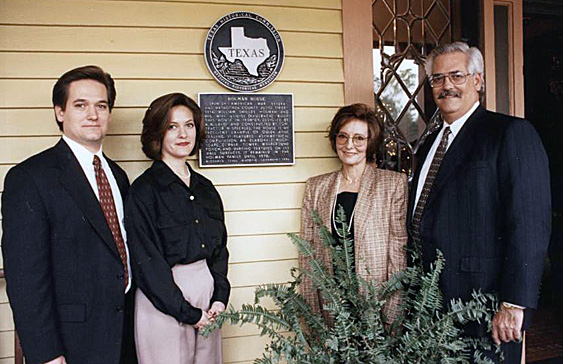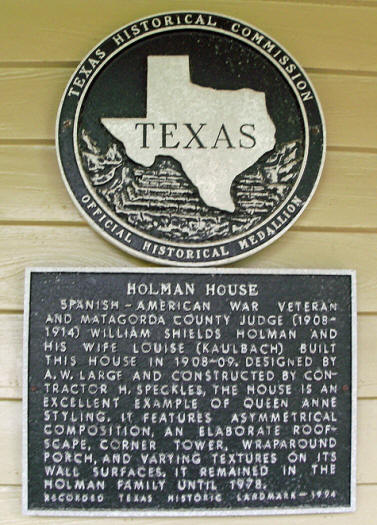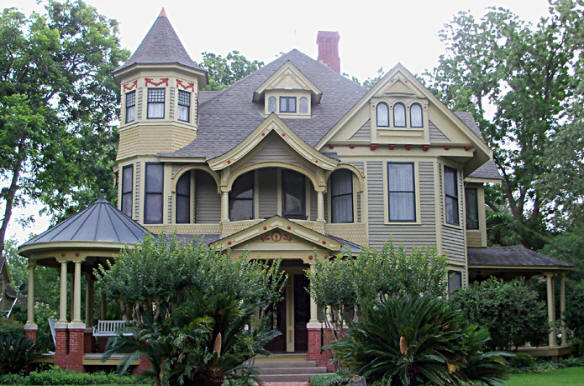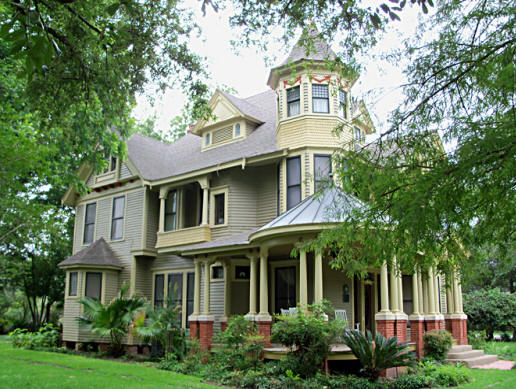|

Marker Dedication - Allen Family
|

|
HOLMAN – ALLEN HOME
By Mary Belle Ingram
On the corner of Avenue K and Third Street, at 2504
Avenue K in Bay City, Matagorda County, Texas, stands the Victorian home
begun in 1908 and completed in 1909 by architect A. E. Large for Judge
and Mrs. William Shields Holman. Mr. H. Speckles was the contractor, a
Mr. Miller the wall paper contractor and Mr. Leopard the concrete
contractor. The home, eight blocks from the Court House Square, is three
stories in height with a two story carriage house in the back and
occupies one quarter of Block 143, Lots 7, 8, and 9, one hundred fifty
feet fronting on Avenue K, one hundred forty feet on Third Street, with
twenty feet for an alley.
In 1894 David Swickheimer, of Dolores County, Colorado, was sole owner
of the townsite of Bay City. Lots 7, 8 and 9, Block 143 are a part of
the east half of the original townsite, consisting of 320 acres of land
out of the western portion of Survey No. 3, Block No. 4 of the I.&G.N.R.R.
Company lands in Matagorda County. On July 1, 1897 David Swickheimer
deeded, among other property, Lots 7, 8 and 9, Block 143 to N. M.
Vogelsang; on February 17, 1898 this property was deeded by N. M.
Vogelsang to M. E. Gibson (Gipson); on March 12, 1903 M. E. and Dora M.
Gipson executed a Warranty Deed in favor of H. B. Kaulbach; H. B.
Kaulbach on March 24, 1903 deeded the property to W. S. Holman; who on
December 30, 1926 deeded it to is wife, Louise Kaulbach Holman. At the
death of Louise Kaulbach Holman on May 15, 1960, this property was
inherited in equal shares by her five children: Jonathan Lane Holman,
who died April 3, 1975; William Shields Holman, Jr., who died March 26,
1975; Louise Holman Miller, Berkeley Watt Holman and Thomas Andrew
Holman. In 1961 Andrew Holman purchased one-fifth interest each from
Berkeley Matt Holman and William Shields Holman, Jr.; Thomas A. Holman
now owning three-fifths interest. On January 8, 1976 the estate of
Jonathan Lane Holman sold one-fifth interest to George A. Miller, Jr.,
who on April 21, 1977 sold his interest to Louise Holman Miller who then
owned two-fifths interest in the property. On January 9, 1978, Louise
Holman Miller and Thomas Andrew Holman sold the property to James M. and
Judith Allen.
(NOTE: The following historical narrative
was written and completed December 6, 1977, by Louise Holman Miller,
daughter of Mr. & Mrs. W. S. Holman and for some years secretary to
Judge Holman.. At that time she had gathered this material toward a
historical marker which was never submitted to the state.)
Will, as the Judge was called, was born in Fayette County, Texas
September 16, 1870 of Southern Colonial stock and died July 2, 1942. his
grandfather, John Thompson Holman, of one of Virginia’s earliest
families, from Glastonbury, England, moved to Texas in 1836. Will won
his law degree at the University of Texas in 1893 and practiced law in
La Grange, Texas. On February 23, 1897 William S. Holman was married to
Miss Louise Kaulbach in La Grange. Miss Kaulbach, born July 31, 1871,
was the eldest daughter of Henry Berkeley Kaulbach, born in Liverpool,
England, the eldest son of a Lunenbrug, Nova Scotia family, and Julia
Fred Kaulbach, La Grange-born daughter of early Texas German parents,
Louise Keilers Frede and Francis Joseph Frede, in whose name was
organized the LaGrange, Texas Chapter of the Sons of the Republic of
Texas. Louise grew up in the distinguished nineteenth century Kaulbach
home at 351 E. Colorado Street, La Grange which now bears a Texas
Historical Medallion. Will and Louise had four sons and one daughter:
Jonathan Lane Holman, who retired in San Antonio as a Major General
following more than forty years in the United States Army; William
Shilds Holman, Jr., of San Antonio, was well-known in Texas furniture
credit circles; Berkely Natt Holman, of Austin had real estate holdings
in Travis and Matagorda Counties; Thomas Andrew Holman, who had been in
cotton buying and mineral leasing leased his own Matagorda County
acreage for rice farming and cattle raising. Will and Louise Holman’s
daughter was Louise Holman Miller, who with her husband, was in oil
operations and later served as Admissions Secretary for Texas Military
Institute.
Near the outbreak of the Spanish American War, on April 28, 1898, Will,
under the La Grange “Historic Oak” of Dawson’s Men and Black Bean fame,
organized Troop H., First Texas Volunteer Cavalry, and served as their
Captain until the emergency ended. In 1902 he moved his family: Mrs.
Holman and then three children, to Bay City, a thriving new town,
practiced law and served as County Judge from November 12, 1908 to
November 11, 1914. He worked diligently to help his area to have good
schools, build good roads, better levees to withstand floods, improve
drainage, introduce new and better crops and to overcome damaging
insects, such as the pink boll worm in cotton. He served actively with
such organizations as the School Board, President of the Mid-Coast
Industrial Congress, Vice President of the National Rivers and Harbors
Congress, on the Executive Committee of the Interstate Inland Waterway
League, as Director of the Colorado River Improvement Association and
helped sponsor the Intra-Coastal Canal as well as encouraged oil
exploration and new residents to the community. In later years he was
elected to the Vestry of St. Mark’s Episcopal Church in Bay City. In
1917, at the outbreak of World War I, Judge Holman was commissioned a
Major and served with troops at Camp Bowie, Texas and subsequently as a
Lieutenant Colonel recruiting in Texas.
The Holman home contains fourteen rooms, three porches, three balconies,
an expansive attic and upstairs hallway, ample closets and three
original fireplaces. The exterior of the home is of Louisiana cypress
weatherboarding, the interior of pine, with wide-planked pine floors.
Metal shingles cover the sharply-pitched roof, on which lightning rods
with ornamental glass balls are mounted. Noteworthy is the Judge’s own
account of, while on a business trip, seeing two carloads of Louisiana
cypress on a railroad siding, inquiring as to who owned it and “buying
it on the spot” for his home. Underground concrete blocks anchor-bolted
to solid pillars of red brick three feet in height were designed to
support the house above the then recurrent floodwaters and to afford
strength against the too-frequent tropical hurricanes, as well as to
provide drying and crawling space under the house.
On the southwest corner of the lot is a peaked-roof two story
outbuilding built for a barn, with stalls for a cow, a calf, a horse and
shelter for a billy goat, a room for feed, harness, bridle and saddle
storage space and a buggy house in which to store the buckboard,
preferred by the Judge to drive to his property outside the city limits.
The servants’ quarters with bath were designed for the second floor and
a convenient lavatory for the ground floor.
The front entrance of the home, facing east, is protected by a large
brick-and-nine-columned porch, continuing ten feet on the south, thus
catching light from the morning sun and the rising moon, as well as the
famous Gulf breezes. A large turret covers the southeast corner of the
porch, with a many-windowed tower on the third floor above. An enjoyable
balcony is above the main entrance, a dormer on the roof above. Of
singular beauty is the front entrance with leaded glass above ornamented
pine panels on either side of and above the heavy relief-decorated pine
and oval plate glass front door. The original hand-turned door bell is
still in operation on the panel to the left. On the right of the
reception hall are eight and a half by two and a half foot double doors
leading to a large parlor. Wide French doors swing open to the spacious
living room. From the left in the reception hall rises the graceful
front staircase, with hand-fashioned newell and nosing and handsome
balustrade. The stair tread, four feet in width, is thirteen inches in
depth and the riser an easy four inches. Three small windows at waist
level light the ample landing, one large window the upper stairs, topped
by a delicate ornamental grille of wood. In the comfortable living room
three tall south windows afford light and breeze. A solid mahogany
mantel and columns border the patterned wrouth-iron-framed fire place on
the northeast corner, north of which is a broad arch topped with
intricate wooded grillwork, opening into the library which leads to a
columned north porch. Eight and a half by two and half foot double doors
open from the living room to the dining room, with a wooden
grillwork-topped bow on the south containing a colorful stained-glass
window between two large windows. Unique is the tall red brick fireplace
with its double mantel. A butler’s pantry leads to the spacious kitchen
with large old fashioned pantry, a convenient latticed porch and a
vestibule with access to the living room and to the rear staircase.
Upstairs, running the depth of the house is a gracefully curved hallway,
five to six feet in width, with waist-height ornamental wainscoting, a
small bathroom at the end of the hall. The spacious master bedroom, with
a red brick fireplace and many windows, is adjoined on the west by a
smaller bedroom, a tiny balcony on the north and on the east the front
upstairs balcony and a bedroom with a beautiful five-windowed tower. A
door to a charming “Romeo and Juliet” balcony opens from the south
bedroom, which adjoins a sizable bedroom on the southwest. Across the
hall a large bathroom conceals the stairway to the expansive partially
floored attic, excellent for storage and rainy day recreation as well as
for viewing from the windowed tower, dormers and other windows.
Throughout the house are twelve foot ceilings, wide-planked pine floors
and door facings, ten inch ornamental pine baseboards, extremely tall
windows with sills seventeen inches from the floor and a beaded cornice
seven and one-quarter inches in depth tops all windows and doors.
Adjustable glass-paned transoms are above most of the doors to provide
more or less air and light. Worthy of mention are the unique pattered
bronze oval door knobs and plates used throughout.
In the late twenties Judge Holman, in failing health, discontinued his
practice of law and lived with his family for five years in San Antonio.
Certain changes were made to the house in order to render it
revenue-producing. Complete outside painting was done. Hand-constructed
pine columns on the front and north porches replaced the original round
ones, not easily available. The deteriorating porch railings were
removed. No alterations were made to the original walls, inside or out.
French doors were placed between the reception hall and the living room.
The sliding doors were hinged for easier mobility. The library was used
as a dining room and the dining room as a bedroom, the adjoining
butler’s pantry was made into a bathroom. The parlor, too, was used for
a bedroom with a portion of the west side partitioned off for a bathroom
and a clothes closet. Upstairs, a partition was erected in the front
hall to form two suites. The north balcony, enclosed to make a bathroom
and the north bedroom used as a kitchen-dinette, with the master bedroom
and the tower bedroom, formed one suite, while the two south bedrooms,
hallway and bath, also larger cedar closet, with kitchenette made of the
large bathroom, formed another suite.
In the late fifties, Mrs. Holman had heavy black asphalt shingles put
upon the roof over the original metal shingles, exterior painting done,
as well as sheet-rocking and painting downstairs, in the front stairwell
and upstairs front hall, at which time the wainscoting was not replaced.
Previously, a large floor furnace was installed under the north arch of
the living room and chimes hung in the reception hall.
In recent years (1970’s) T. A. Holman, George A. Miller and Louise
Holman Miller had the main kitchen and its furniture redecorated and a
new sink installed. Also, they had three bathrooms rebuilt and
artistically decorated, the floor furnace put into working order, water
heaters re-worked and certain woodwork downstairs refinished.
The present [1994] owners, Mr. and Mrs. James M. Allen, who acquired the
property in 1978 have made extensive improvements using the best
materials and workmanship available to restore the home to its original
beauty and strength. Following the original plans they returned the home
to its original intent of a single family dwelling. After consulting
with A. J. Wildrodt, A.I.A., a noted restoration architect of Columbus,
Texas, the Allens removed all partitions, doors and fixtures that were
not a part of the original house construction. A 330-340-lb. GAF
“Timberline” shingle roof was installed after removal of the
deteriorating asphalt that was in place. The turrets were clad in copper
to replace the original terne plate, which had been “tarred” to prevent
leaks. The porches were repaired and the exterior was completely
repainted following the original color scheme of the house. Interior
renovations included adding drywall over the shiplap walls that had not
already been drywalled; stripping and refinishing all interior woodwork
to original including floors; complete rewiring of the house including
addition of outlets not present in the original; replumbing of the
entire house with use of the original fixtures where possible and the
addition of other period fixtures where it was not; removal of one
original wall separating the small kitchen from the butler’s pantry to
create a larger kitchen that would accommodate modern appliances with
the addition of cabinets where none existed before; interior walls were
either painted or papered in period colors; the double doors were rehung
as pocket doors as original intended. The separate carriage house was
also restored and modified to serve as a garage with a slab and driveway
poured and upstairs servant’s quarters were made habitable again with
the addition of bath and kitchen fixtures. Landscaping included planting
Heritage oak and cypress trees to replace dead or dying hackberry trees;
adding brick walkways and many indigenous shrubs and bedding plants
where originally intended following plans provided by A. Glueck of
Columbus, Texas who was referred by the architect.
James and Judith Allen are natives of Bay City, and active in civic
affairs. James is a CPA and serves as treasurer of the Bay City Library
Association. Judith serves on the board of trustees of the Matagorda
County Museum Association.
In the Cultural Resource survey done by the Houston-Galveston Area
Council in 1979 of Matagorda County historic structures, Woods K.
Wellvorn, Jr., Preservation/Planning Consultant recommended the
Holman-Allen Home for both the National Register and for a Texas
Historical marker.
The dedication for the Texas Historical Marker for
the Holman House, 2504 Ave K, Bay City, Texas, was held December 30,
1995.
HOLMAN HOUSE
SPANISH-AMERICAN WAR VETERAN AND
MATAGORDA COUNTY JUDGE (1908-1914) WILIAM SHIELDS HOLMAN AND HIS WIFE
LOUISE (KAULBACH) BUILT THIS HOUSE IN 1908-09. DESIGNED BY A. W. LARGE
AND CONSTRUCTED BY CONTRACTOR H. SPECKLES, THE HOUSE IS AN EXCELLENT
EXAMPLE OF QUEEN ANNE STYLING. IT FEATURES ASYMMETRICAL COMPOSITION, AN
ELABORATE ROOFSCAPE, CORNER TOWER, WRAPAROUND PORCH, AND VARYING
TEXTURES ON ITS WALL SURFACES. IT REMAINED IN THE HOLMAN FAMILY UNTIL
1978.
RECORDED TEXAS HISTORIC
LANDMARK (1994)
|




